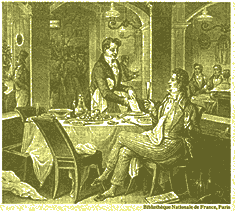

|

 Review
of
Review
of
THE lNVENTlON OF THE RESTAURANT:
Paris
and
the Modern Gastronomic Culture.
By
Rebecca L. Spang
. Harvard University
Press.
Review originally pub-lished in "NYTimes
Shelf Life," Oct. 7,
2000.
|
efore
sitting down at an inn to eat a meal he couldn't pay for
and setting off on a journey to Paris he couldn't afford,
the destitute Rabelais ostentatiously put aside a few
packages that were sure to attract attention. they were
labeled "poison for the king and "poison for
the dauphin."
When the innkeeper found them after the meal, he immediately
had
Rabelais arrested and transported to Paris
,
where he was welcomed by the king with hearty laughter
at the free trip and
the bill-avoiding scheme.
Since then, we are told
by Rebecca L. Spang
in
this pleasingly spiced history of the restaurant, any
occasion when the
bringing of a check
has led to
surprise or embarrassment has been called
"le
quart d'heure de Rabelais,"
Rabelais's quarter-hour.
For him it ended in triumph, but for others the 15 minutes
have brought far more discomfort.
After the French Revolution, for example, in June 1791,
Louis XVI and Marie Antoinette tried to flee France in
disguise and stopped to eat at Varennes, where they were
royally served by a restaurateur appropriately named Sauce.
Varying degrees of gluttony have been ascribed to that
last supper, but some accounts imagine the
king's arrest
as a classic Rabelaisian quarter-hour: as the check is
presented, the portrait on the money is seen to bear a
close resemblance to the corpulent diner.
But the
settlement of accounts
is always a bit
awkward, and these anecdotes, with their elements of duplicity
and disguise, only emphasize how much of the restaurant
experience -- the fresh linen, the genuflecting servants,
the artfully prepared dishes -- really is a
masquerade
.
The restaurant is a space that is neither private nor
public; everything costs money, but the pretense is that
nothing does; the food is freshly prepared, but there
is no sign of cooking.
The arrival of the check pulls the masks away: all of
this is illusion,
a staged drama.
Your servants
have moved onto other customers, your stained tablecloth
is hastily hidden. Louis was seen to be the king he was
trying not to be; the rest of us are seen not to be the
kings we were trying to be.
But how has this
restaurant ritual
come to be?
And why does it have this form? Such questions are now
familiar in works of cultural and social history. Western
institutions and customs are treated as anthropological
artifacts packed with unexplored meanings.
Ms. Spang, who teaches modern European history at University
College, London, adds to the genre without falling prey
to its jargon. The ingredients are a bit unsystematically
combined, but they are there in all their strangeness:
the birth of the French
"gastronomer"
(the
first of whom, in the early decades of the 19th century,
thought it was far more rewarding to concentrate on "
the
stupidest goose
than the sweetest woman"); the
impenetrable menus (what, Ms. Spang wonders, is
pigeon
g la crapaudine"
given that "crapaud"
is a toad and "rapaudine" a disease of sheep?;
the private "cabinets" in 19th century Parisian
restaurants (in which fairs and assignations were consummated
before or after the consommé).
Most histories until now, she writes, have argued that
the restaurant had its origins in the years after the
French Revolution when the unemployed cooks of the aristocracy
set up shop in a
new bourgeois
universe.
But, she points out, the restaurant s origins developed
out of a "cult of sensibility in the middle of 18th
century
. Unlike an inn or a tavern
with community
tables, scheduled mealtimes and an atmosphere of raucous
and perhaps unsavory company, the restaurant was
specifically a place on went
not to eat
.
It was a place where customers who suffered from delicate
dispositions and weak chests would literally
be restored.
A restaurant was not originally a place to eat but the
dish being eaten: a broth with purported
medicinal
properties
, cooked in a sealed pot in which the essences
of meats and vegetables were turned into a concentrated,
restorative liquid. A restaurant served restaurants while
offering its discerning clientele: small tables, private
rooms and flexible mealtimes.
These establishments, in Ms. Spang's telling, had a difficult
time after the French Revolution, when a revolution in
gustatory habits included
populist potluck
community
dinners eaten in the streets. In contrast the restaurant
could seem aristocratic, even
corrupt
. So its precious
atmosphere began to change.
Menus expanded and were codified. In the sybaritic years
of the late 18th century the restaurant became a refuge
from the demands of
public life
. In its mirrored
rooms, where diners could contemplate one another along
with their food, a new art form, gastronomy, took root.
The doctrine of art for
its own
sake was supplemented
by food for its own sake.
But Ms. Spang asks, "Was it really the food that
attracted people to restaurants?" She suggests instead
that restaurants offered "a prime arena for the
anxious
interplay
of hierarchy and democratization characteristic
of modern social life."
A young American woman novelty of restaurants in 18th-century
Paris, wondering how to act and feast her eyes, wrote,
"It really requires some practice." The restaurant
hid from view the
swill and sweat
of cookery, lustful
eagerness of human appetite, the
snobbery
and envy
of
social life
, and cloaked it all in finery and
manners. At least until that final Rabelesian quarter-hour.
|

|
Dine Like
Rabelais (Till the Bill Comes)
by E Rothstein
Pub. "NY Times, Shelf Life, Oct. 7, 2000."
-------------------------------------------------
THE lNVENTlON OF THE RESTAURANT
Paris and the Modern Gastronomic Culture
By Rebecca L. Spang. Harvard University Press. 325
pages. $35
|
|
|
|


